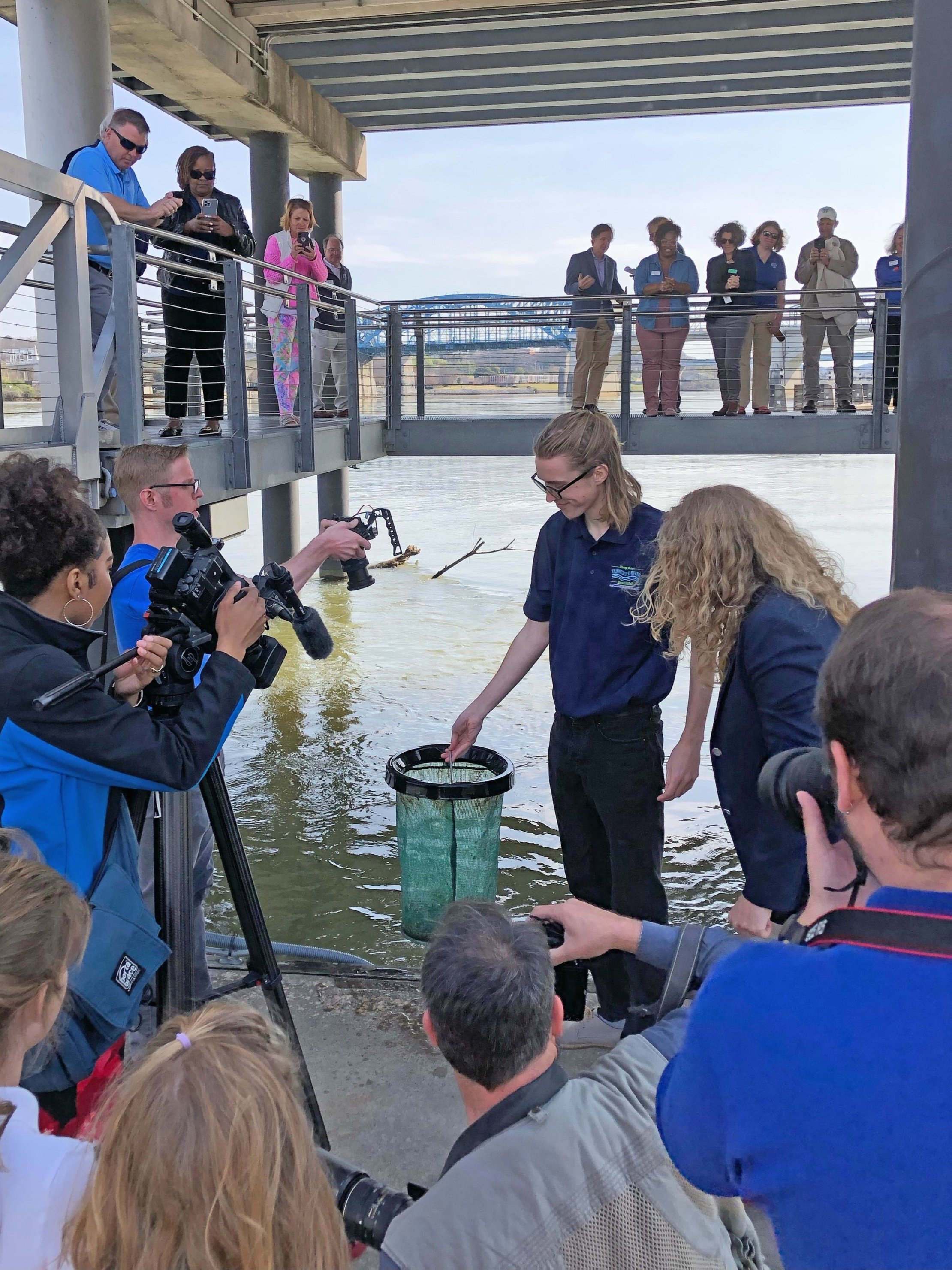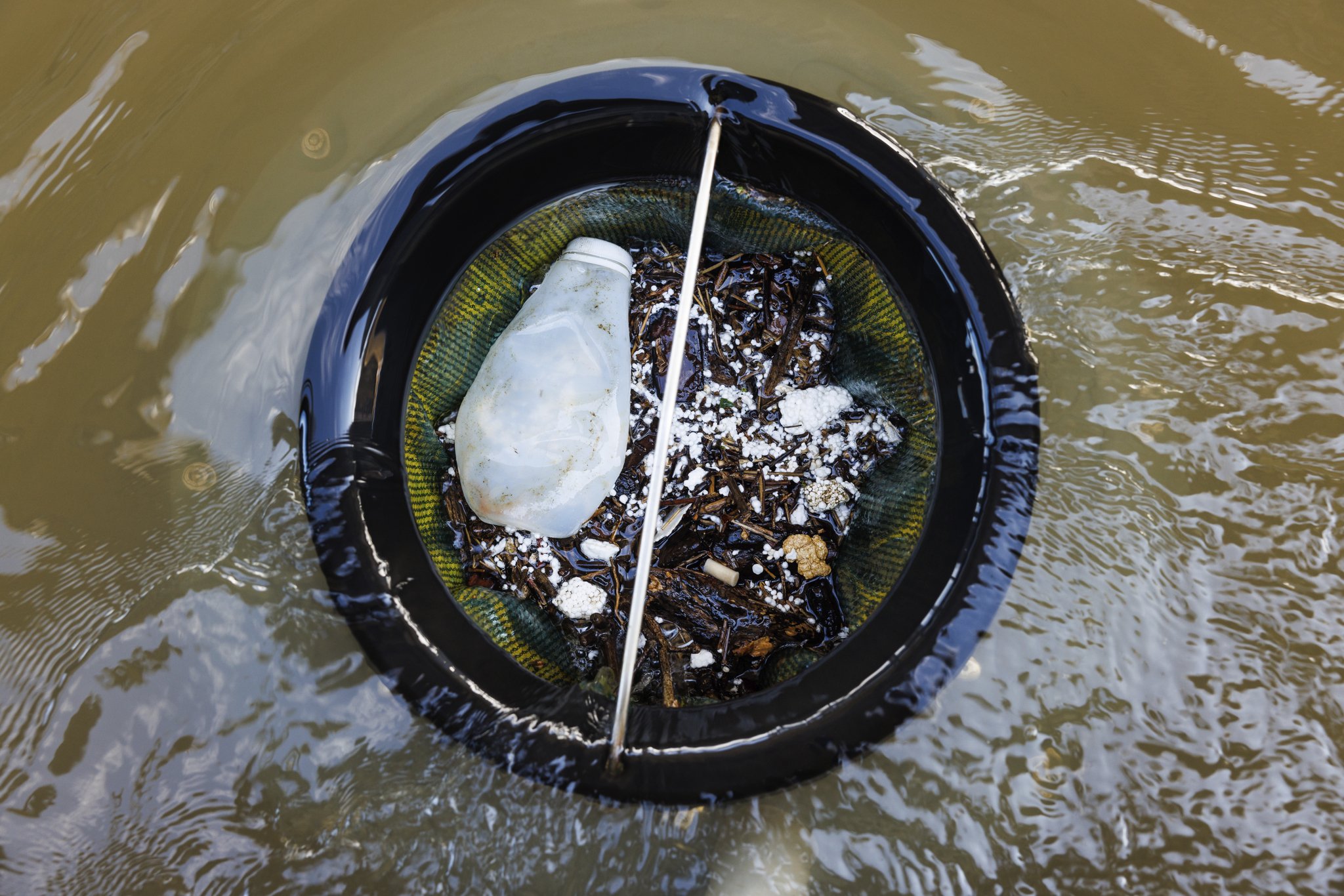KTNRB AmeriCorps Member Isaac Christman shows off to the media and officials the recent collections of the newest Seabin installed on the Tennessee River and in front of the Tennessee Aquarium in Chattanooga, Tenn. at a press conference for KTNRB’s Seabin Project announced on World Water Day (3.22.22).
The Tennessee River and some of its tributaries are about to become home to the largest network of electric litter skimmer devices on any river system in the world. Keep the Tennessee River Beautiful (KTNRB) is working with partners across the seven-state Tennessee River watershed to install 18 Seabin devices, all thanks to two large grants from the Tennessee Dept. of Transportation (TDOT) and Keep America Beautiful (KAB).
KTNRB Executive Director, Kathleen Gibi, speaks at the Seabin press conference on World Water Day (3.22.22) at the site of the Seabin managed by the Tennessee Aquarium in Chattanooga, Tenn.
The Seabin device, a product out of Australia, works 24/7 to collect marine debris from the surface of the water, much like a pool skimmer that’s electrically operated. Each device can remove up to 3,000 lbs. of marine debris a year, meaning that the 18 devices installed along the Tennessee River watershed will have the potential of removing up to 54,000 lbs. a year. Even more than that, the devices will also filter out gasoline, oils, and microplastics from the water.
Tennessee Aquarium staff clean out the Seabin device located on the Chattanooga Pier on the Tennessee River in Chattanooga, Tenn.
“Until now, all of our work has only been able to prevent microplastics in our waterways, so we are thrilled to be making an effort to actually mitigate microplastics out of the water,” said Kathleen Gibi, Executive Director for KTNRB. “We’re grateful to TDOT and Keep America Beautiful for these—as I see it—revolutionary grants and to our partners who will be maintaining the Seabins to make this trailblazing project possible.”
The Seabins are currently installed and maintained primarily by marina staff in Tennessee, Alabama, and North Carolina. KTNRB is still looking to find a home for six remaining Seabins. As part of the grant, each Seabin overseer will document the amount and types of litter collected so that the data can be analyzed. Seabins are either installed or are about to be installed at the following sites:
- Louisville Landing Marina | Louisville, Tenn.
- Volunteer Landing Marina | Knoxville, Tenn.
- Tennessee Aquarium | Chattanooga, Tenn.
- Harrison Bay State Park | Soddy Daisy, Tenn.
- Pickwick Landing State Park | Hardin County, Tenn.
- Paris Landing State Park | Paris, Tenn.
- Lake Ocoee Inn & Marina | Benton, Tenn.
- Tellico Marina | Vonore, Tenn.
- Clifton RV & Marina | Clifton, Tenn.
- Fontana Village Resort & Marina | Fontana, N.C.
- Joe Wheeler State Park | Rogersville, Ala.
- Florence Harbor Marina | Florence, Ala.
KTNRB made the announcement of the Seabin project today on World Water Day alongside representatives from TDOT, KAB, the City of Chattanooga, and the Tennessee Aquarium.
The Aquarium is a special partner in KTNRB’s Seabin project, managing one of the 18 Seabins on the City of Chattanooga’s river walk in front of their facility. As an educational institution with a freshwater science center, the Aquarium will be integrating Seabins into educational programming and examining any litter trends discovered through the Seabin network collections.
Trash collected in the Seabin at the Tennessee Aquarium in Chattanooga, Tenn.
"Healthy communities depend upon healthy rivers, lakes, and streams," said Dr. Anna George, the Aquarium's VP of Conservation Science and Education. "The Seabins network will give us new opportunities to engage students and the public to show them how litter continuously flows from the land and into our waterways."
After the 2017 "TenneSwim" study by Dr. Andreas Fath of Furtwangen University showed that the water near the surface of the Tennessee River contains microplastic concentrations 80 times higher than those found in Germany's Rhine River, the Tennessee Aquarium set a course to better understand and combat the problem. Dr. Fath's study brought public attention to this growing threat, but left scientists asking why our river contains so much plastic.
Collaborative efforts are underway to better understand the prevalence of microplastics in Southeastern rivers today, the types and potential sources of these plastics, and eventually learn how microplastics affect aquatic animals' health.
The Seabin device installed at Louisville Landing Marina on the Tennessee River in Louisville, Tenn.
"We're hopeful that we can turn this tide of freshwater plastic around by collaborating with partners like TDOT, Keep the Tennessee River Beautiful, and others to urge the public to reduce single-use plastics, recycle the rest and join in cleanup efforts that help improve our water quality," said Dr. George.
Of the 18 Seabin devices along the Tennessee River watershed, TDOT’s ‘Nobody Trashes Tennessee’ litter campaign provided funding to KTNRB for 10 devices to be purchased. Nobody Trashes Tennessee has also been funding KTNRB’s volunteer litter cleanups, Adopt a River Mile program, and Cigarette Litter Prevention Program.
“TDOT’s partnership with Keep the Tennessee River Beautiful demonstrates the connectedness of roadside litter to that which ends up in our waterways.” Said TDOT’s Interim Commissioner Joseph Galbato, III. “Assisting with this new network of litter removing devices is just another way that TDOT is helping to make our state cleaner and greener.”
The other eight Seabin devices have been funded through grants from Keep America Beautiful, who first introduced KTNRB to the Seabin device. Leading up into 2020, Seabin devices had been used in Australia, Europe, and Asia for years. A Seabin distributing company known as The SEArial Cleaners based out of France approached Keep America Beautiful about introducing Seabins to the United States. The national nonprofit then selected three KAB affiliates to test a Seabin pilot project on different bodies of water: one along an inland lake (Keep Ohio Beautiful), one oceanfront site (Keep New Hanover Beautiful), and one inland river (Keep the Tennessee River Beautiful).
After installing two Seabin devices in East Tenn. at Volunteer Landing Marina and Louisville Landing Marina, KTNRB reported success with the product. In 2021, KAB announced a nationwide grant for Seabin devices to their local KAB affiliates. KTNRB received six Seabins in the grant and then collaborated with Keep the Shoals Beautiful in Florence, Ala. who also received two Seabins through the same grant.
Cigarette butts and bottle caps are common litter items collected in Seabin devices. This photo shows collections made from the Tennessee River at Volunteer Landing Marina in Knoxville, Tenn.
“The leadership and innovation of the Keep the Tennessee River Beautiful and Keep the Shoals Beautiful is truly inspirational and a model for the over 700 Keep America Beautiful Affiliates across the nation,” said Randy Hartmann, Senior Director of Keep America Beautiful. “With over 26 billion pieces of litter found along-side our nation’s waterways, it is critical to clean up this litter.
The beauty of the Seabin program is that it captures the ‘small litter’ which comprises almost nine out of ten littered items counted in the 2020 KAB Litter Study.”
In rolling out their Seabin project, KTNRB recruited partners to oversee the Seabins and then used the grant money to purchase the Seabins and have them delivered to each site. Staff at KTNRB will be compiling the litter data reported by each site manager. Gibi said the goal is to use the data to hopefully identify litter trends and sources so that new steps can be taken to stop litter flow into our waterways.
“We at Keep the Tennessee River Beautiful are very serious when we say that we’re aiming to work ourselves out of work, and coming at the litter from different angles such as litter prevention and education, physical litter cleanup, and now electric-powered filtration of our waterways will help us achieve that end game,” said Gibi. “When you look at all of the partners who came together to make our Seabin network possible, it’s obvious that we’re all determined to protect our precious Tennessee River, the most beautiful and biodiverse river in the nation.”
To learn more, visit www.KeepTNRiverBeautiful.org/seabin.







